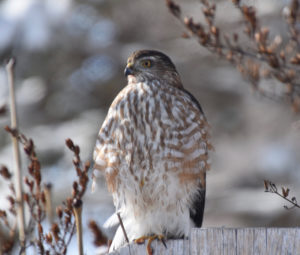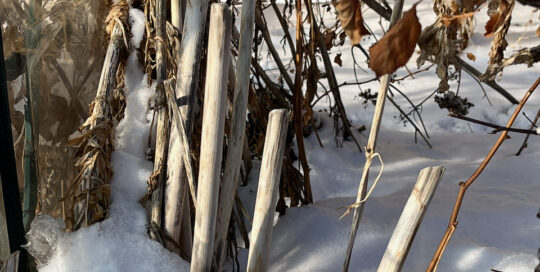Protecting backyard birds from hungry hawks
Views: 1225

One positive aspect of winter is watching the birds at the bird feeder. While it benefits our feathered neighbors, it also sets up a situation where they are on the menu.
Lunchtime for everyone
Last winter we sat at our kitchen table having lunch, and noticed a beautiful hawk sitting on the top of the fence. We determined it was a sharp-shinned hawk – thanks to pouring through bird books such as a Peterson field guide along with the Montana Birding group on Facebook. Sharp-shinned hawks are beautiful and we were tickled with its visit.
The sparrows weren’t so happy. Imagine our surprise when we looked out again and noticed the hawk had a sparrow grasped in its talons. I won’t describe its eating habits. This became a regular occurrence. At least once a week, the hawk returned and a sparrow went missing.
Hawks figure out the food source
Taking advantage of a concentrated food source isn’t new, but the numbers are increasing. According to numbers gathered by Project Feeder Watch of Cornell Lab of Ornithology and Bird Studies Canada, hawks utilize feeders as their personal buffet. In the article, Prey abundance and urbanization influence the establishment of avian predators in a metropolitan landscape, the authors show the pattern. In the 1990s hawks were at 26% of the sites. Twenty years later, they’re at 67% of the areas. This study was in Chicago, but the trend is widespread.
Give little birds a better chance
There are two ways to look at this situation. One: Hawks need to eat. Two: The poor sparrows don’t deserve to be plucked from their feeder. To prevent the latter, make a few changes around the feeder to give them a fighting chance.
Feeder placement is important
If a hawk makes a dive for the birds, there’s nothing worse than slamming into the glass to be stunned or killed. Place the feeder where the small birds have a path to escape.
Take a look around the feeding area to see if there are ideal spots for a hawk to sit to plan an attack. Try to move the feeder out of the direct line of this vantage point. Along these lines, also choose a location near cover where the birds can hide in between seed snatching.
Feed the birds now so they eat garden pests
Use caged feeding stations
Utilizing caged feeders allows the little birds to reach the seeds while protected from an attack. These are really ingenious. Some of these feeding stations are quite large, allowing ample room for the small birds to perch and feed. If you’re looking for a balance between providing a benefit to the small birds, this is a good choice.
Never harm the hawks
While it might tug on the heart strings to see a little bird become a meal, remember that you cannot harm or injure hawks. The Migratory Bird Treaty Act makes it a federal offense, so not only is it unnecessary, it means a hefty fine.
Understand these beautiful predators need to eat, and unless you want to take down your feeders all together, take a few measures to give the small birds a better chance.
Meet Amy Grisak
Amy is a freelance author and photographer in Great Falls, MT who specializes in gardening, foods, and sustainable agriculture. She provides information on every kind…
Amy's Recent Posts

This Little Piggy is a Problem: Dealing with Feral Hogs








